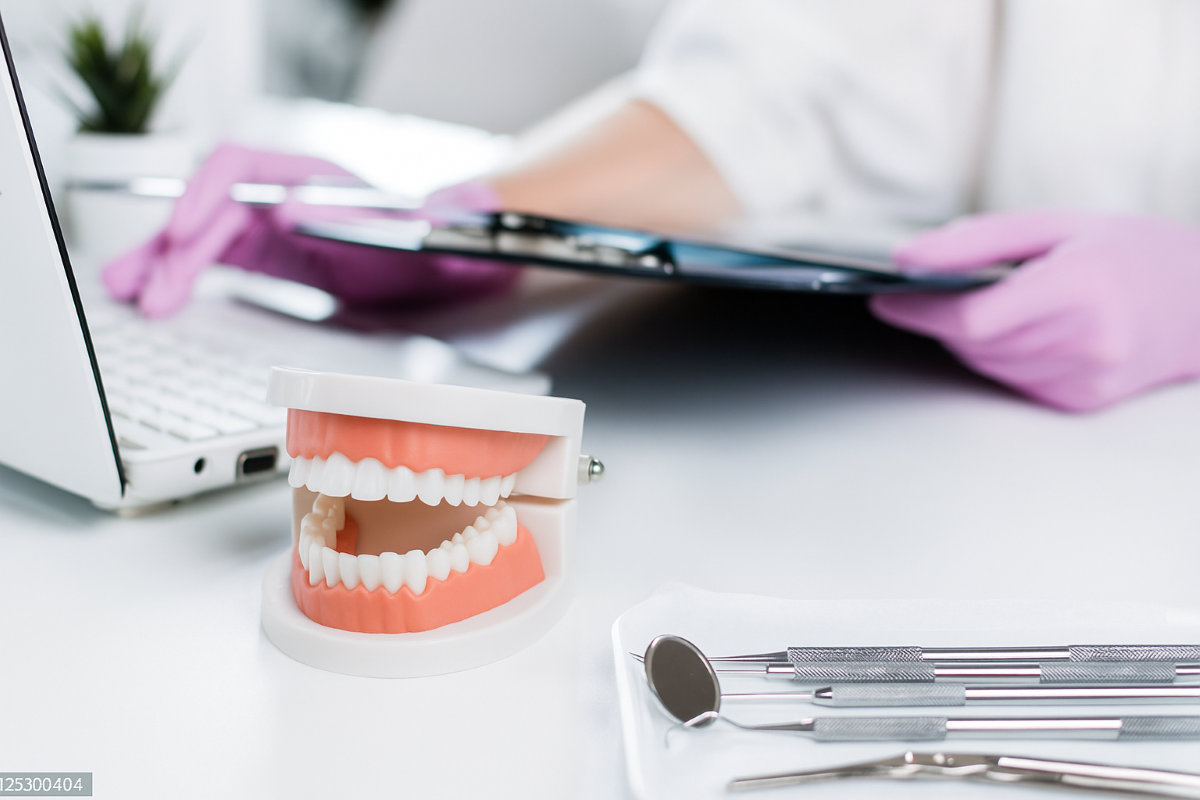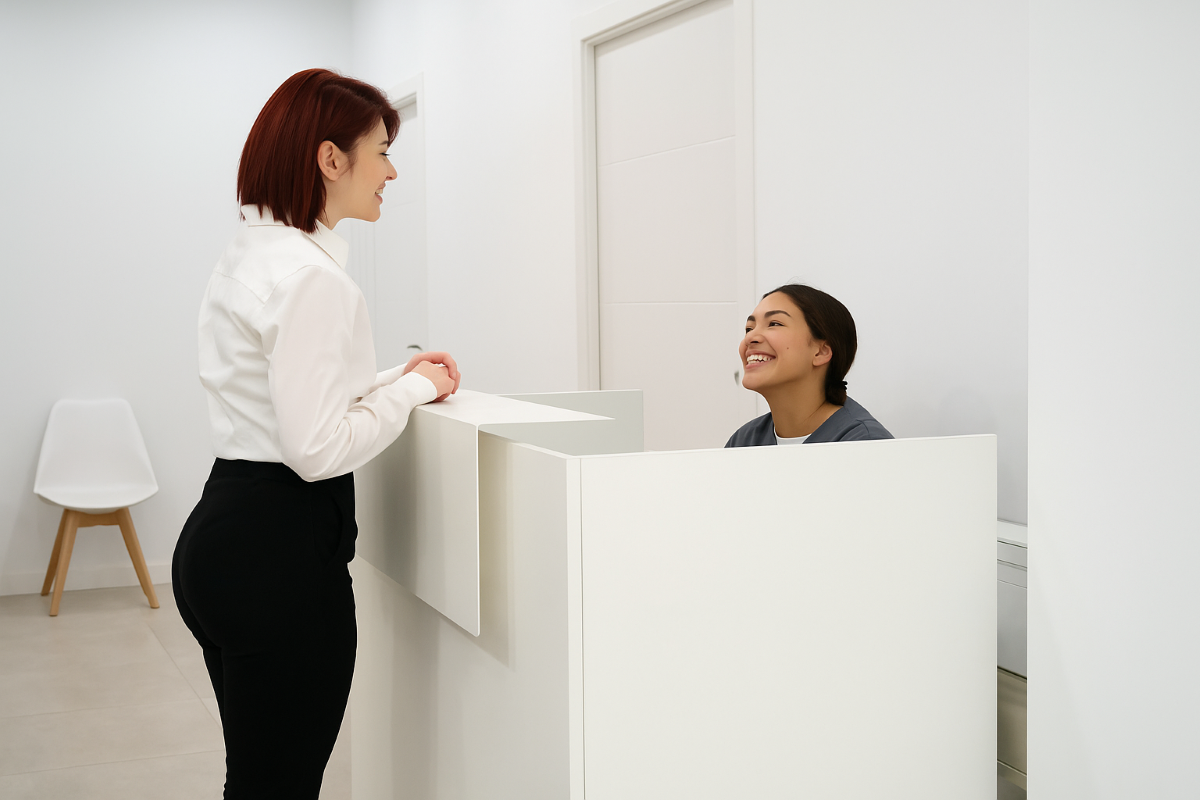Key Highlights
AI dental receptionists improve the patient experience by automating tasks. They are there 24/7.
These systems handle phone calls, set up appointments, send reminders, and answer common questions about office hours and services.
While AI manages routine tasks, your human staff can spend more time on patient care.
Dental practices have several AI options to meet their needs and budget. This can lead to cost savings and better efficiency.
For AI to work properly, careful planning is needed. Training staff and clear patient communication about data privacy and how the technology helps in their care is also important.
Introduction
In today's busy world, a good patient experience is very important. Long wait times, tricky schedules, and constant updates can make staff feel stressed and lower patient satisfaction. This is where the AI receptionist becomes essential. This new technology helps change how dental practices work and interact with patients. This blog will look into what AI receptionists can do, the benefits they provide, and ways to enhance service quality and make work processes better.
Understanding AI Dental Receptionists
Imagine a front desk that can easily manage appointments, answer patient questions, and provide quick information anytime. This is what a virtual receptionist, or an AI dental receptionist, can do. These smart systems take care of many routine tasks. They help schedule appointments, send reminders, gather patient information, and respond to common questions.
When you use AI receptionists to handle tasks, your human staff can focus on more important work. This allows them to give better patient care. As a result, workflows get easier, wait times become shorter, and the overall patient experience improves.
The Role of AI in Modern Dental Practices
The front office of dental practices is going through many changes. A lot of this change is due to advanced technology. AI-powered solutions are very common now. They help dental offices work better. This makes the work more efficient and improves patient care.
AI receptionists are a big step forward for the dental industry. They take care of administrative tasks. This allows the staff to focus more on patient care. As a result, the workplace becomes more efficient and zeroes in on helping patients.
Dental offices that use this technology can benefit in many ways. These benefits are shorter wait times, better scheduling, improved communication, and higher patient satisfaction. As AI gets better, it will have a bigger part in modern dental practices. This will be key for their success.
How AI Dental Receptionists Transform Patient Experience
In healthcare, patient satisfaction is very important. AI dental receptionists are changing the game. They help practices improve patient engagement and the way services are provided.
These AI receptionists respond to questions fast. They help you schedule appointments easily. They also make communication run smoothly. This gives patients a better and less stressful experience. They tailor their responses and provide helpful details. This approach improves the personalized patient experience, making patients feel appreciated and involved.
When we mix personalized care with quick services and shorter wait times, it makes patients feel happy. Happy patients are often more loyal and give a practice a better reputation.
Beginner's Guide to Implementing AI Dental Receptionists
Starting your journey with AI might feel overwhelming, but taking it step by step can help. First, figure out what you really need. Look for any issues in your current setup that AI could solve. For example, do you miss calls often? Does scheduling feel stressful for you?
When you understand the problems in your practice, it’s easier to pick the right AI software. Look for features that fit what you need. Ensure it works well with your practice management systems.
Step 1: Assessing Your Dental Practice's Needs
Before you begin using AI in your dental practice, think about your unique needs. Every practice is different. It's important to find out what challenges you face and where AI can really help.
Are you missing a lot of calls that lead to lost chances and unhappy patients? Is your staff overwhelmed with too many administrative tasks? This makes it hard for them to focus on patient care. By spotting these issues, you can see how AI can help boost operational efficiency.
AI can help improve the way your practice runs without interrupting it. If you take a moment to assess what you need, you will be better at picking the right AI tools. This will help you get the most out of them.
Step 2: Choosing the Right AI Receptionist Software
Choosing the right AI system for your dental practice is very important for achieving the best results. Start by looking into various providers and what they can deliver. Think about costs related to things like language support, how easily it fits into your practice, customization choices, and its potential to grow with your practice.
Pay attention to the service quality of the AI system. Check how accurate and natural its answers are. Notice if it understands different accents. Also, see how well it handles patient inquiries.
Lastly, choose systems that combine AI with human help. AI works well for routine tasks. However, it is important to easily switch to a person for complex or sensitive problems. This way, you maintain a high standard of patient interaction and satisfaction.
Step 3: Customizing AI Features to Match Practice Workflow
After you pick your AI receptionist software, it’s important to adjust the features to fit your office workflow. You need to set up the system to handle common patient inquiries. This involves giving clear information about office hours, services, and insurance coverage.
You need to change appointment scheduling so it matches the needs of your practice. It's key to set up automatic reminders and follow-up messages. This can lower the chances of no-shows and keep patients updated.
By changing these features, you will make the AI receptionist work better with how you currently do things. This will reduce any issues and improve efficiency.
Step 4: Integrating AI Receptionist with Existing Systems
Integrating your AI receptionist with your practice's systems is important for a smooth setup. You need to work closely with your software providers. This helps data move easily between the practice management software and the AI system. Always remember to keep data security in mind during this process.
Think about adding features slowly, step by step. Start with simple things, like appointment reminders. As you move forward, you can add more complex tasks. These can be insurance verification and managing patient inquiries as you learn more.
Using a hybrid approach can be helpful in the beginning. This means that human staff and the AI receptionist team up to manage tasks during the first phase of using the AI.
Step 5: Monitoring and Adjusting AI Functions
Using an AI receptionist takes regular effort. You need to check it often and make updates to ensure it works well. Pay attention to how the AI communicates with patients. Keep an eye on important things like its ability to schedule appointments and patient satisfaction. Also, gather feedback from both staff and patients. This will help you see where changes can be made for improvement.
You can check the data from the AI system. This will help you see how patients act, what questions they usually ask, and where you can make changes. This information can guide you to make better choices. You can modify workflows, improve AI answers, and enhance the patient experience.
AI is always changing and getting better. By updating the system, your AI receptionist can use the latest features. This allows it to continue offering key benefits like better efficiency, improved service quality, and higher patient satisfaction.
Advantages of Using AI Dental Receptionists
Using AI dental receptionists offers several benefits. First, you can save money by automating tasks that extra staff would normally handle. AI can work all day and night. It answers calls, schedules appointments, and gives information, even when your office is not open.
AI does more than provide practical help. It improves the patient experience, too. You get quick answers and better service quality with personalized interactions. This can lead to more patient satisfaction. By taking care of routine tasks, AI helps human staff focus on offering caring and attentive support.
Reducing Patient Wait Times Significantly
Long wait times can frustrate patients and lower patient satisfaction. AI dental receptionists help solve this problem. They make appointment scheduling easier, send automated reminders to reduce no-shows, and improve patient flow. All of this helps to decrease delays.
AI receptionists assist by quickly answering patient inquiries. They provide instant answers to common questions. This helps make check-in and scheduling simpler. It leads to a smoother experience and lowers perceived wait times.
When things work more efficiently, patients feel better. Your staff can spend more time providing personal care. They won’t be stuck dealing with administrative tasks. This makes patients happier and helps your practice run smoothly. Over time, this will also lead to cost savings.
Enhancing Patient Satisfaction and Engagement
In today's online world, patients hope for quick service and easy experiences. AI dental receptionists can improve the patient experience. They give fast answers, make appointment scheduling simple, and provide friendly communication.
AI receptionists help make dental care simpler for patients. They are available all day, every day. They can send appointment reminders automatically. Patients can also reach out through text, email, or voice. This easy access and quick service boost patient engagement. It also builds a strong bond between patients and the practice.
AI can take care of many administrative tasks. But we must remember the need for the human touch. It's important to blend AI’s skills with the caring actions of your staff. When patients need extra attention or emotional support, this combination is essential for creating a really good patient experience.
Challenges and Solutions
Using AI in dentistry has many advantages, but there are challenges too. A main worry is data security, especially when it comes to protecting patient information. It is important to select AI providers that follow HIPAA rules and have strong security measures. This helps keep sensitive data safe.
Patients sometimes feel confused. They struggle with using technology instead of talking to real people. To help with this, we should explain how AI works. We need to stress that AI supports human interaction. It does not take it away.
Addressing Privacy and Security Concerns
It's common to feel worried about privacy when using AI with sensitive patient information. We must address these concerns to build trust. This will help make sure that AI is used fairly.
First, pick AI providers that focus on data security and follow key rules like HIPAA. Make sure the system you choose has strong encryption, access controls, and safe data storage. This will help keep sensitive health information safe.
Talk openly with your patients about how you use their data and keep it safe. Give clear information on what the AI system does. Explain how it stores data and what rights they have for data privacy. Being honest builds trust. It shows that you care about using AI in a responsible way.
Measuring the Impact of AI Dental Receptionists
To get the best results from an AI dental receptionist, you need to see how it affects your dental practice. Keep an eye on important numbers to check if the system is working well for you.
Keep track of how many patients come in, how many appointments you set up, and how many people don't show up. This will help you see how the AI receptionist is changing the way you work. It's also important to get patient satisfaction information through surveys or feedback forms. This will help you understand how the AI receptionist impacts wait times, the quality of communication, and how happy the patients feel overall.
Key Metrics to Track Success
It is very important to measure how well your AI receptionist is performing. By watching key numbers, you can see how it impacts practice management and patient satisfaction.
Pay attention to the volume of calls handled by the AI receptionist. Also, check how many appointments are scheduled and if there are fewer missed or abandoned calls. This will help you see how well it manages patient communication. Look at the information on appointment reminders, confirmations, and no-shows. This will help you understand its impact on missed appointments and how it improves scheduling.
Use patient surveys to check patient satisfaction. Focus on things like wait times, the clarity of communication, and the overall experience with the AI receptionist.
Metric | Description | Target |
|---|---|---|
Volume of Calls Handled | Measures the number of incoming calls managed by the AI receptionist. | Increase in calls handled by AI |
Appointment Scheduling Rate | Tracks the percentage of successful appointment bookings through the AI system. | Improvement in appointment booking rate |
No-Show Rate | Monitors the percentage of patients who miss appointments after AI reminder implementation. | Reduction in no-show percentage |
Patient Satisfaction Score | Measures the overall satisfaction level of patients interacting with the AI receptionist. | Increase in positive patient feedback |
Conclusion
In conclusion, AI dental receptionists are changing how we care for patients. They help reduce wait times and make people happier. By using AI technology in your dental practice, you can improve workflow and be more efficient. It’s important to address privacy issues and any worries about AI to ensure it works well. By looking at key metrics and learning from real-life successes, you can see how AI receptionists boost the patient experience. This is a good way to improve patient care in your dental practice.
Are you ready to improve your practice with AI? Contact us today to set up a consultation!
Frequently Asked Questions
What makes AI dental receptionists different from traditional receptionists?
AI technology helps dental receptionists with their routine tasks. It can schedule appointments, send reminders, and answer common questions. This technology offers immediate responses at any time, whether it's day or night. By using this technology, clinics can reduce human error and lower their operational costs.
How do AI dental receptionists reduce patient wait times?
AI dental receptionists serve as virtual helpers. They simplify appointment scheduling. They ensure patients have a smooth experience by sending reminders on time and answering questions effectively. All this leads to much shorter wait times.
Can AI dental receptionists handle emergency dental requests?
AI can respond to emergency requests quickly. However, some complicated cases need people to step in to make sure patient care is right. Still, AI can make appointment bookings easier for urgent situations.
Are there any privacy concerns with using AI in dentistry?
Taking care of privacy concerns is very important. Good AI companies put in a lot of effort into data security. They follow strict data management methods to keep patient information safe. By choosing HIPAA-compliant systems, you help create trust. This also makes sure that AI is used in a responsible way.
How can practices transition smoothly to an AI receptionist system?
A successful change occurs when the staff receive proper training. You need to explain to patients what the AI receptionist can do. It's also important to connect the new system with what is currently being used. Finally, ensure you have a clear plan for managing the change.




